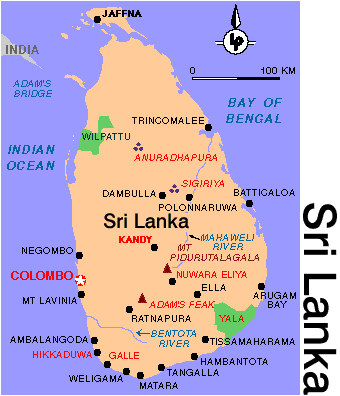

|
------------ ------------ ------------ |
|
Geography: Sri Lanka Sri Lanka, island country in the Indian Ocean off the southeastern coast of India. Formerly known as Ceylon, the country has a total area of 65,610 sq km (25,332 sq mi). The administrative capital is Sri Jayavardhanapura. The commercial capital and largest city is Colombo. Land and Resources Sri Lanka's outstanding topographical feature is a mountainous mass in the south central part of the country. In this upland region are two plateaus, Nuwara Eliya and Horton Plains. North of the mountains, and extending south, is an arid and gently rolling plain known as the dry zone. The west, south, and southeast coasts are indented by palm-fringed lagoons and inlets. The rugged northeastern coast contains Trincomalee Harbor, one of the best natural harbors in the world. Sri Lanka's climate is hot and humid, but the mountains and hills are cool, and humidity is lower in the dry zone. The natural resources are chiefly agricultural, although the land is not easily cultivated. Tropical jungles occupy extensive areas in the southwest, and the mountain slopes are thickly forested. The animal life is diverse and includes many species that may be in danger of extinction. Population The population (1995 estimate) of Sri Lanka is 18,346,000. Most of the people live in rural areas. About 74 percent of the population is of Sinhalese descent, and the largest minority group is the Tamils (18 percent). Religion plays an important role in Sri Lanka. Most public holidays are based on religious festivals. Sixty-nine percent of the population is Buddhist. Other religions include Hinduism, Christianity, and Islam. The official language is Sinhalese, spoken by more than 70 percent of the population. Tamil is spoken in the northern and eastern provinces, and English is widely used. Education is compulsory from 5 to 15 years of age and free to the university level. Economy Sri Lanka's economy is based on agriculture. Most people are subsistence farmers, growing rice on small plots. The dominant exports are tea, rubber, and coconuts, which make up nearly 35 percent of Sri Lanka's export earnings and are grown on large, government-owned plantations. In the 1970s the government nationalized most major industries and businesses, but attempts are under way to privatize the economy. Mechanized industry is relatively limited. The Sri Lankan rupee is the monetary unit (50 rupees equal U.S.$1; 1995). Government Under a 1978 constitution, Sri Lanka's chief executive and head of state is a president elected to a six-year term. The president appoints the prime minister and members of the cabinet and may dismiss parliament at will. A unicameral parliament of 225 members is elected by a system of proportional representation. History According to tradition, Vijaya, a Hindu prince from northern India, conquered the island in 504 BC, naming it Sinhala. His descendants reigned for several centuries over a highly civilized society. Buddhism became the national religion in the 3rd century BC. From the 3rd century AD to the middle of the 12th century, Sinhala was dominated by Tamil kings and invaders from southern India. Native princes then regained power. The Chinese occupied the island from 1408 to 1438. In the 16th century the Portuguese gained control, but they were ousted by the Dutch in 1658. Great Britain captured the area in the late 1700s, and in 1802 the island was formally ceded to the British, who developed the tea and rubber estates. Their rule, however, was marked by an ongoing struggle for national freedom. During World War II (1939-1945), the island was an important base and source of materials for the Allied war effort. In 1948 Sri Lanka—known then as Ceylon—attained independence under the leadership of D. S. Senanayake of the United National Party (UNP). The nation's leadership has since alternated between the UNP and the Sri Lanka Freedom Party (SLFP). After years of economic decline, a leftist coalition led by the SLFP's Sirimavo Bandaranaike won election in 1970 and nationalized major industries and businesses. In 1972 the name Sri Lanka was adopted. In 1978 the UNP won elections and began reversing the socialist trends of its predecessor. In 1983 civil war erupted between the Sinhalese-dominated government and the rebel Liberation Tigers of Tamil Eelam (LTTE), which sought a separate nation for the Tamil minority. Despite a temporary truce enforced by Indian troops from 1987 to 1989, hostilities resumed in 1991, and Sri Lanka continues to be plagued by terrorism and political assassination. Since fighting between the two groups began, about 40,000 people have been killed. |

Produced & Maintained By Shantha Abeysekera